2-Amino-5-methoxybenzenesulfonic acid
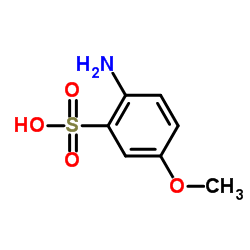
2-Amino-5-methoxybenzenesulfonic acid structure
|
Common Name | 2-Amino-5-methoxybenzenesulfonic acid | ||
|---|---|---|---|---|
| CAS Number | 13244-33-2 | Molecular Weight | 203.216 | |
| Density | 1.5±0.1 g/cm3 | Boiling Point | N/A | |
| Molecular Formula | C7H9NO4S | Melting Point | 314-318ºC | |
| MSDS | N/A | Flash Point | N/A | |
| Name | p-Anisidine-3-sulfonic acid |
|---|---|
| Synonym | More Synonyms |
| Density | 1.5±0.1 g/cm3 |
|---|---|
| Melting Point | 314-318ºC |
| Molecular Formula | C7H9NO4S |
| Molecular Weight | 203.216 |
| Exact Mass | 203.025223 |
| PSA | 98.00000 |
| LogP | 0.34 |
| Index of Refraction | 1.595 |
Synonym:4-Aminoanisole-3-Sulfonic Acid; 4-Methoxy-2-Sulfoaniline Section 2 - COMPOSITION, INFORMATION ON INGREDIENTS
Risk Phrases: 36/37/38 Section 3 - HAZARDS IDENTIFICATION EMERGENCY OVERVIEW
Irritating to eyes, respiratory system and skin. Potential Health Effects Eye: Causes eye irritation. May cause chemical conjunctivitis. Skin: Causes skin irritation. Ingestion: May cause gastrointestinal irritation with nausea, vomiting and diarrhea. May cause methemoglobinemia, cyanosis (bluish discoloration of skin due to deficient oxygenation of the blood), convulsions, and death. Inhalation: Causes respiratory tract irritation. May cause methemoglobinemia, cyanosis (bluish discoloration of skin due to deficient oxygenation of the blood), convulsions, tachycardia, dyspnea (labored breathing), and death. Inhalation may be fatal as a result of spasm, inflammation, edema of the larynx and bronchi, chemical pneumonitis and pulmonary edema. May cause burning sensation, coughing, wheezing, laryngitis, shortness of breath, headache, nausea, and vomiting. Can produce delayed pulmonary edema. Chronic: May cause methemoglobinemia, which is characterized by chocolate-brown colored blood, headache, weakness, dizziness, breath shortness, cyanosis (bluish skin due to deficient oxygenation of blood), rapid heart rate, unconsciousness and possible death. Effects may be delayed. Section 4 - FIRST AID MEASURES Eyes: Immediately flush eyes with plenty of water for at least 15 minutes, occasionally lifting the upper and lower eyelids. Get medical aid. Skin: Get medical aid. Flush skin with plenty of water for at least 15 minutes while removing contaminated clothing and shoes. Wash clothing before reuse. Ingestion: Never give anything by mouth to an unconscious person. Get medical aid. Do NOT induce vomiting. If conscious and alert, rinse mouth and drink 2-4 cupfuls of milk or water. Wash mouth out with water. Inhalation: Remove from exposure and move to fresh air immediately. If not breathing, give artificial respiration. If breathing is difficult, give oxygen. Get medical aid. Do NOT use mouth-to-mouth resuscitation. Notes to Physician: Treat symptomatically and supportively. For methemoglobinemia, administer oxygen alone or with Methylene Blue depending on the methemoglobin concentration in the blood. Antidote: Methylene blue, alone or in combination with oxygen is indicated as a treatment in nitrite induced methemoglobinemia. Section 5 - FIRE FIGHTING MEASURES General Information: As in any fire, wear a self-contained breathing apparatus in pressure-demand, MSHA/NIOSH (approved or equivalent), and full protective gear. During a fire, irritating and highly toxic gases may be generated by thermal decomposition or combustion. Runoff from fire control or dilution water may cause pollution. Extinguishing Media: Use foam, dry chemical, or carbon dioxide. Use water spray, dry chemical, carbon dioxide, or appropriate foam. Section 6 - ACCIDENTAL RELEASE MEASURES General Information: Use proper personal protective equipment as indicated in Section 8. Spills/Leaks: Vacuum or sweep up material and place into a suitable disposal container. Clean up spills immediately, observing precautions in the Protective Equipment section. Avoid generating dusty conditions. Provide ventilation. Section 7 - HANDLING and STORAGE Handling: Minimize dust generation and accumulation. Avoid breathing dust, vapor, mist, or gas. Avoid contact with eyes, skin, and clothing. Keep container tightly closed. Avoid ingestion and inhalation. Use with adequate ventilation. Wash clothing before reuse. Storage: Store in a tightly closed container. Store in a cool, dry, well-ventilated area away from incompatible substances. Section 8 - EXPOSURE CONTROLS, PERSONAL PROTECTION Engineering Controls: Facilities storing or utilizing this material should be equipped with an eyewash facility and a safety shower. Use adequate ventilation to keep airborne concentrations low. Exposure Limits CAS# 13244-33-2: Personal Protective Equipment Eyes: Wear appropriate protective eyeglasses or chemical safety goggles as described by OSHA's eye and face protection regulations in 29 CFR 1910.133 or European Standard EN166. Skin: Wear appropriate protective gloves to prevent skin exposure. Clothing: Wear appropriate protective clothing to prevent skin exposure. Respirators: Follow the OSHA respirator regulations found in 29 CFR 1910.134 or European Standard EN 149. Use a NIOSH/MSHA or European Standard EN 149 approved respirator if exposure limits are exceeded or if irritation or other symptoms are experienced. Section 9 - PHYSICAL AND CHEMICAL PROPERTIES Physical State: Solid Color: Not available. Odor: Not available. pH: Not available. Vapor Pressure: Not available. Viscosity: Not available. Boiling Point: Not available. Freezing/Melting Point: Not available. Autoignition Temperature: Not available. Flash Point: Not available. Explosion Limits, lower: Not available. Explosion Limits, upper: Not available. Decomposition Temperature: Solubility in water: Specific Gravity/Density: Molecular Formula: C7H9NO4S Molecular Weight: 203.1273 Section 10 - STABILITY AND REACTIVITY Chemical Stability: Stable at room temperature in closed containers under normal storage and handling conditions. Conditions to Avoid: Incompatible materials, dust generation, excess heat, strong oxidants. Incompatibilities with Other Materials: Oxidizing agents. Hazardous Decomposition Products: Nitrogen oxides, carbon monoxide, irritating and toxic fumes and gases, carbon dioxide. Hazardous Polymerization: Has not been reported Section 11 - TOXICOLOGICAL INFORMATION RTECS#: CAS# 13244-33-2: DB4950000 LD50/LC50: CAS# 13244-33-2: Draize test, rabbit, eye: 500 mg/24H Mild; Draize test, rabbit, skin: 500 mg/24H Mild; Oral, rat: LD50 = 10 gm/kg. Carcinogenicity: 2-Amino-5-Methoxybenzenesulfonic Acid - Not listed by ACGIH, IARC, or NTP. Other: See actual entry in RTECS for complete information. Section 12 - ECOLOGICAL INFORMATION Section 13 - DISPOSAL CONSIDERATIONS Dispose of in a manner consistent with federal, state, and local regulations. Section 14 - TRANSPORT INFORMATION IATA Not regulated as a hazardous material. IMO Not regulated as a hazardous material. RID/ADR Not regulated as a hazardous material. Section 15 - REGULATORY INFORMATION European/International Regulations European Labeling in Accordance with EC Directives Hazard Symbols: XI Risk Phrases: R 36/37/38 Irritating to eyes, respiratory system and skin. Safety Phrases: S 26 In case of contact with eyes, rinse immediately with plenty of water and seek medical advice. S 37/39 Wear suitable gloves and eye/face protection. WGK (Water Danger/Protection) CAS# 13244-33-2: 1 Canada CAS# 13244-33-2 is listed on Canada's NDSL List. CAS# 13244-33-2 is not listed on Canada's Ingredient Disclosure List. US FEDERAL TSCA CAS# 13244-33-2 is listed on the TSCA inventory. SECTION 16 - ADDITIONAL INFORMATION N/A |
CHEMICAL IDENTIFICATION
HEALTH HAZARD DATAACUTE TOXICITY DATA
|
| Hazard Codes | Xi:Irritant; |
|---|---|
| Risk Phrases | R36/37/38 |
| Safety Phrases | S37/39-S26 |
| RTECS | DB4950000 |
| HS Code | 2922299090 |
|
~95% 
2-Amino-5-metho... CAS#:13244-33-2 |
| Literature: Jagadeesh; Karthikeyan; Nithya; Sandhya, Y. Sree; Reddy, S. Sudhaker; Reddy, P. Pradeep Kumar; Kumar, M. Vinod; Charan, K.T. Prabhu; Narender; Bhagat Journal of Molecular Catalysis A: Chemical, 2010 , vol. 328, # 1-2 p. 99 - 107 |
|
~96% 
2-Amino-5-metho... CAS#:13244-33-2 |
| Literature: Bruyneel, Frederic; Payen, Olivier; Rescigno, Antonio; Tinant, Bernard; Marchand-Brvnaert, Jacaueline Chemistry - A European Journal, 2009 , vol. 15, # 33 p. 8283 - 8295 |
|
~% 
2-Amino-5-metho... CAS#:13244-33-2 |
| Literature: Chemistry - A European Journal, , vol. 15, # 33 p. 8283 - 8295 |
|
~% 
2-Amino-5-metho... CAS#:13244-33-2 |
| Literature: Chemistry - A European Journal, , vol. 15, # 33 p. 8283 - 8295 |
|
~% 
2-Amino-5-metho... CAS#:13244-33-2 |
| Literature: DE146655 ; |
| HS Code | 2922299090 |
|---|---|
| Summary | 2922299090. other amino-naphthols and other amino-phenols, other than those containing more than one kind of oxygen function, their ethers and esters; salts thereof. VAT:17.0%. Tax rebate rate:13.0%. . MFN tariff:6.5%. General tariff:30.0% |
| Benzenesulfonic acid, 2-amino-5-methoxy- |
| p-Anisidine-2-sulfonic Acid |
| MFCD00035804 |
| 2-Amino-5-methoxybenzenesulfonic acid |
| EINECS 236-224-2 |
| 4-Methoxyaniline-2-sulfonic Acid |
| 4-Aminoanisole-3-sulfonic Acid |
![6-Methoxybenzo[d]thiazole structure](https://image.chemsrc.com/caspic/221/2942-13-4.png)
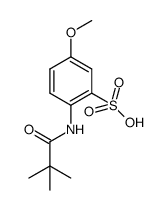

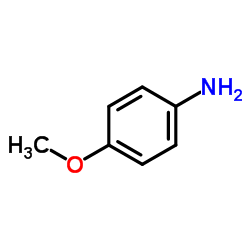

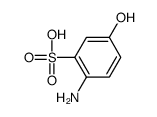 CAS#:2835-05-4
CAS#:2835-05-4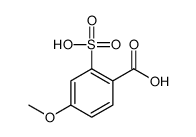 CAS#:40567-33-7
CAS#:40567-33-7